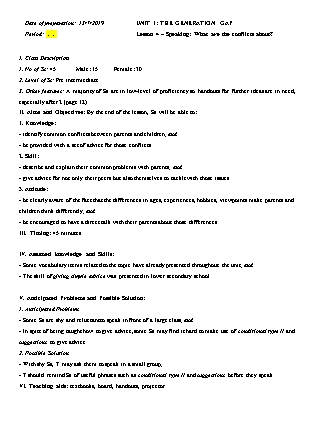Giáo án Tiếng Anh Lớp 10 - Unit 1: The generation gap - Lesson 4: What are the conflicts about? - Năm học 2019-2020

I. Class Description
1. No of Ss: 45 Male: 15 Female: 30
2. Level of Ss: Pre intermediate
3. Other features: A majority of Ss are in low-level of proficiency so handouts for further ideas are in need, especially after 2 (page 12).
II. Aims and Objectives: By the end of the lesson, Ss will be able to:
1. Knowledge:
- identify common conflicts between parents and children; and
- be provided with a set of advice for those conflicts.
2. Skill:
- describe and explain their common problems with parents; and
- give advice for not only their peers but also themselves to tackle with those issues.
3. Attitude:
- be clearly aware of the fact that the differences in ages, experiences, hobbies, viewpoints make parents and children think differently; and
- be encouraged to have a direct talk with their parents about those differences.
III. Timing: 45 minutes
Date of preparation: 13/7/2019 Period: UNIT 1: THE GENERATION GAP Lesson 4 – Speaking: What are the conflicts about? I. Class Description 1. No of Ss: 45 Male: 15 Female: 30 2. Level of Ss: Pre intermediate 3. Other features: A majority of Ss are in low-level of proficiency so handouts for further ideas are in need, especially after 2 (page 12). II. Aims and Objectives: By the end of the lesson, Ss will be able to: 1. Knowledge: - identify common conflicts between parents and children; and - be provided with a set of advice for those conflicts. 2. Skill: - describe and explain their common problems with parents; and - give advice for not only their peers but also themselves to tackle with those issues. 3. Attitude: - be clearly aware of the fact that the differences in ages, experiences, hobbies, viewpoints make parents and children think differently; and - be encouraged to have a direct talk with their parents about those differences. III. Timing: 45 minutes IV. Assumed knowledge and Skills: - Some vocabulary items related to the topic have already presented throughout the unit; and - The skill of giving simple advice was presented in lower secondary school. V. Anticipated Problems and Possible Solution: 1. Anticipated Problems - Some Ss are shy and reluctant to speak in front of a large class; and - In spite of being taught how to give advice, some Ss may find it hard to make use of conditional type II and suggestions to give advice. 2. Possible Solution - With shy Ss, T may ask them to speak in a small group; - T should remind Ss of useful phrases such as conditional type II and suggestions before they speak. VI. Teaching aids: textbooks, board, handouts, projector. VII. Teaching Procedure 1. Oral checking: No 2. Checking attendance: 1’ 3. New lesson (42’) Step/Activity Aims and Mode of Interaction T’s Activities Ss’ Activities WARM -UP (3’) 1. Ask and answer - Aim: arouse Ss’ interest and background knowledge of the topic, and lead to the topic. - Interaction: the whole class. - Asks Ss to look at picture c (page 12) and asks them: 1. Is the appearance of the children accepted by your father/ mother? 2. Is hair or clothing the problem? - Elicits Ss and leads to the topic. - Act as assigned BEFORE YOU SPEAK (10’) 2. Read and match 3. Read and tick - Aim: Ss identify and realize the current issues that others are facing. - Interaction: individual work - Aim: Ss express their issues with parents - Interaction: individual work - Asks Ss to read 1 (page 12) and match with the appropriate headings. - Gives feedback - Asks Ss to read 2 (page 12) and tick the issues in their families. - Act as assigned - Take notes - Act as assigned WHILE YOU SPEAK (???) 4. Share the issues 5. Elicit solutions/ advice for the issues 6. Make a conversation - Aim: practice speaking skills, be aware of their real situations. - Interaction: pair work - Aim: provide Ss with ideas to develop the discourse on domestic problems and solutions. - Interaction: pair work and group work - Aim: practice a longer conversation and consolidate the learning points. - Interaction: pair work - Asks Ss to work in pairs and share the domestic issues - Walks around to help if necessary. - Asks Ss to think of advice/ solution to certain issues; - Provides handouts of advice/ solutions for Ss; - Asks Ss to choose appropriate solutions/ advice. - Asks some Ss to present the solutions/ advice to certain problems. - Asks Ss to look at 3 (page 12), useful phrases and the sample conversation; - Analyzes the sample and asks Ss to make a similar one, choosing their real issues; - Asks 2-3 pairs to practice and - Gives feedback. - Work in pairs and share the ideas - Answer T’s questions - Receive handouts and choose - Present their potential solutions/ advice. - Act as assigned - Take notes and make a conversation - Present in front of the class - Take notes. AFTER YOU SPEAK (???) 7. Write a summary - Aim: consolidate - Asks Ss to use a mind map to write about the most urgent/ serious issue and propose some solutions. - Asks 1-2 Ss to share in front of the class. - Act as assigned - Present and take notes VIII. Consolidation and Homework (2’) 1. Consolidation: T consolidates some main points of the lesson. 2. Homework: ?????
Tài liệu đính kèm:
 giao_an_tieng_anh_lop_10_unit_1_the_generation_gap_lesson_4.docx
giao_an_tieng_anh_lop_10_unit_1_the_generation_gap_lesson_4.docx



